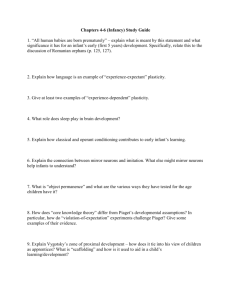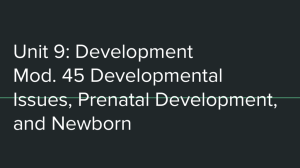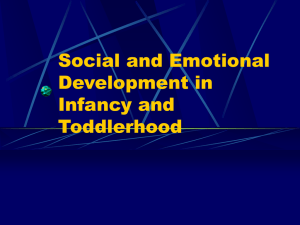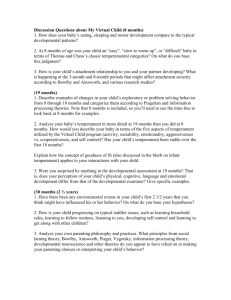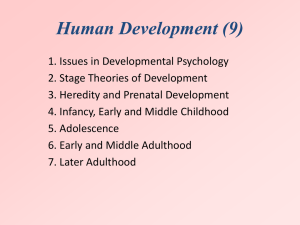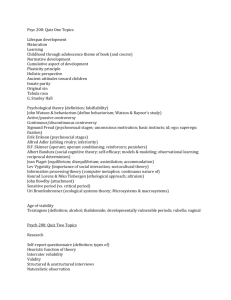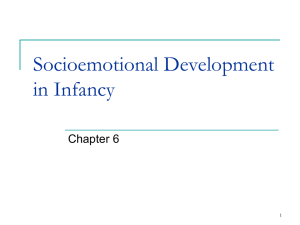No. Umur (bulan) Ekspresi emosi
advertisement
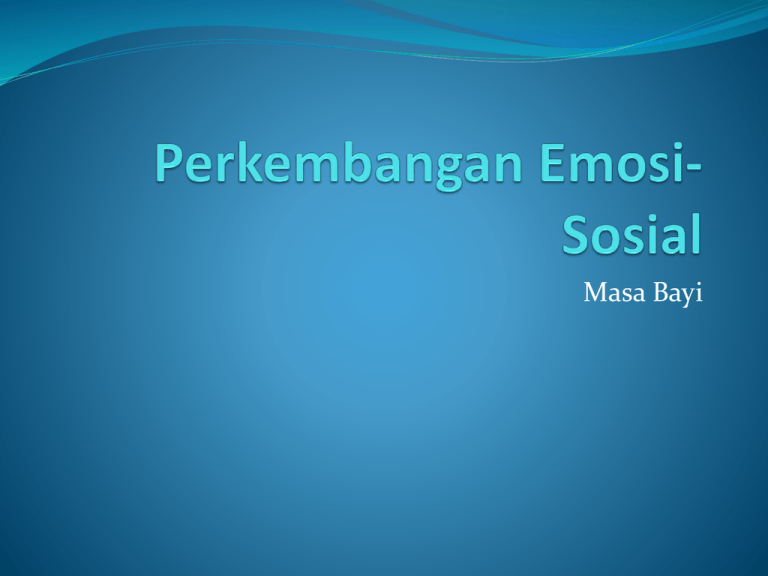
Masa Bayi Fungsi ekspresi emosi bayi Adaptasi dan kelangsungan hidup Regulasi komunikasi PERKEMBANGAN EMOSI BAYI No. Umur (bulan) Ekspresi emosi 1. 0–1 Senyumn sosial 2. 3 Senyum kesenangan 3. 3-4 Kehati-hatian 4. 4 Keheranan 5. 4-7 Kegembiraan,kemarahan 6. 5-9 Ketakutan 7. 18 malu Periode Perkemb angan Bayi (birth to 18 or 24 bulan ) Standar Dasar Perkembangan dalam Dimensi Social-Emotional Kompetensi Sosial Attachment Kompetensi Emosional • Tertarik pada orang; menunjukkan keinginan untuk perhatian personal • Berkemampuan mengkoordinasi kan interaksi • beinisiatif kontak dengan teman sebaya • Formasi ikatan attachment bond dng orang dewasa • awalan “internal working model” attachment–– i.e.,munculnya security or insecurity attachment • Expresi dasar emosi • Reaksi yg berbeda pada emosi orang dewasa • regulasi emosi; beberapa kenyamanna n-diri, banyak dibantu oleh orang dewasa Kompetensi Penerimaan – Diri • Merespon pada namanya; mengenali diri • Mengekpresikan kepemilikan/me nuasai Temperamen/ Kepribadian • Menunjukkan dimensi yg berbeda atas regulasi-diri dan reaktifiti Erikson Theory Identified 8 stages: Basic trust vs mistrust (birth - 1 year) Autonomy vs shame and doubt (ages 1-3) Initiative vs guilt (ages 3-6) Industry vs inferiority (ages 6-11) Identity vs identity confusion (adolescence) Intimacy vs isolation (young adulthood) Generativity vs stagnation (middle adulthood) Integrity vs despair (the elderly) Erikson Theory Identified 8 stages: Basic trust vs mistrust (birth - 1 year) Autonomy vs shame and doubt (ages 1-3) Initiative vs guilt (ages 3-6) Industry vs inferiority (ages 6-11) Identity vs identity confusion (adolescence) Intimacy vs isolation (young adulthood) Generativity vs stagnation (middle adulthood) Integrity vs despair (the elderly) Erikson’s Theory Erikson characterized Freudian stage as inner conflict that is resolved positively or negatively depending on child’s experiences with caregivers Trust vs. Mistrust Conflict of infancy-trust vs. mistrust 1st stage- oral stage- infants obtain pleasure through mouth Healthy outcome depends on quality of mother’s behavior during feeding not amount of food or oral stimulation Dilemma is resolved positively if caregiving is sympathetic and loving Autonomy vs. Shame and Doubt Conflict of toddlerhood-autonomy vs. shame and doubt 2nd stage- anal stage- take pleasure in retaining and releasing urine and feces at will Resolved positively if parents provide suitable guidance and appropriate choices Emotional Development Facial features are most reliable cues for emotional expression in infancy Different facial expressions are associated with similarly cross-culturally Basic emotions- happiness, interest, surprise, fear, anger, sadness and disgust 6 months- faces, voice and posture forms patterns that clearly related to social events Maternal depression can disrupt emotional and social development in child Table 6.1 Happiness Binds parent and baby and fosters the infant’s developing competence Social smile- the smile evoked by the stimulus of the human face- first appears between 6 to 10 weeks Laughter first appears around 3 to 4 months in response to active stimuli Anger and Fear Anger is expressed during first months through crying in response to unpleasant stimulus Fear increases about the sixth month and after : reasoning- survival, keep exploration in check; social signals to motivate caregivers Stranger anxiety- expression of fear in response to unfamiliar adults. Dependent on child’s temperament, past experiences with strangers and the situation in which the stranger is met. Anger and Fear Cognitive development influences the role of fear and anger in infants- intentional behavior-8-12 months Culture also influences emotions through childrearing practices. Understanding and Responding to the Emotions of Others Between 7 – 10 months infants perceive facial expressions as organized patterns, and they can match the emotional tone a voice with the appropriate face of the speaking person Social referencing- infant relies on a trusted person’s emotional reaction to decide how to respond in an uncertain situation-after 10 months –method of indirectly learning about the environment for infants and toddlers Self-Conscious Emotions Self-conscious emotions appear at the end of second year. Higher- order emotions-shame, pride, embarrassment (malu), guilt, and envy (cemburu) Involve injury or enhancement of our sense of self Self conscious emotions assist children in acquiring socially valued behaviors and goals Beginnings of Emotional SelfRegulation Emotional self-regulation-strategies used to adjust emotional stages to a comfortable level of intensity In early months of life, infants only have a limited capacity to regulate their emotional states By end of first year, babies ability to move around permits them to regulate feelings more effectively by approaching or retreating from various stimuli Cultural and Gender Differences American culture encourages positive feelings more often than negative ones Infant boys get more training in hiding their sadness than girls. Cultures that stress collectivism over individualism usually place greater emphasis on socially appropriate behavior Temperament and Development Temperament- stable individual differences in quality and intensity of emotional reaction NY Longitudinal Study (Thomas and Chess) - examined temperament Results- Temperament is somewhat predictive of psychological adjustment Parenting Practices can modify children’s emotional styles Structure of Temperament Easy child- established regular routines; generally cheerful, and adapts easily Difficult child- irregular routines, slow to accept new experiences, reactions are negative and intense Slow-to- warm up child-inactive, mild low key reactions to environment; adjusts slowly Some children show blend of different temperaments Measuring Temperament Temperament is assessed using Parent interviews and questionnaires Behavior ratings Direct researcher observations Physiological measured utilized to hopefully identify biological processes as factors for temperamental styles Genetic Influences Twin studies reveal that identical twins are more similar than fraternal twins in a wide range of temperamental traits and personality measures About half of the individual differences among us can be traced to differences in our genetic makeup Heredity does play a role in temperament development Environmental Influences Parenting and Child rearing practices influence temperament Cultural practices influence temperament Temperament differences exist between in children in the same family The Goodness-of-fit model Goodness of fit model explains how an effective match between child-rearing practices and a child’s temperament can lead to favorable adjustment Difficult children are less likely than easy children to receive sensitive care Goodness of fit depends in part on cultural values Underextention and Overextension Underextension word applied to fewer objects and events. example – Buppie for child’s personal cup and cup for other cups Overextension- word is applied to a wider collection of objects, persons or events example Mommy used for all women Attachment Infants’ strong affectional tie to familiar caregivers Attachment does not depend on hunger satisfaction Research with rhesus monkeys reared with terrycloth and wire-mesh “surrogate mothers” showed clinging to terrycloth “mother” regardless of which “mother” provided food. Bowlby’s ethological theory of attachment Infant’s relationship with a parent begins with the baby’s innate signals that trigger parenting behaviors Preattachment phase-birth-6- infants do not yet respond differently to a familiar caregiver than to a stranger Attachment in the making phase 6 weeks to 6-8 months-infant responds differently to parent but does not object to separations Phase of “clearcut” atttachment-upset and protest when familiar caregivers leaves-separation anxietyappears universally around the world (after 6 months and increasing until 15 months of age) Formation of reciprocal relationship (18 months to 2 years and on)-begin to understand relationship of parent’s coming and going; children will talk about the parents’ plans and when they will return, leading to a reduction in separation protest Tahap-tahap Pembentukan attachment No. Tahap Usia/bulan Tingkah laku 1. Indiscriminate Sociability 0-2 Bayi tidak membedakan antara orangorang, merasa senang dengan atau menerima dengan senang orang yang dikenal dan yang tidak dikenal 2. Attachment is the makin 2-7 Bayi mulai mengakui dan menyukai orang yang dikenal, tersenyum pada orang yang lebih dikenal 3. Spesific, clear cut attachment 7-24 Bayi mengembangkan keterikatan dengan ibu atau pengasuh pertama lainnya dan akan berusaha senantiasa dekat dengannya, akan menangis ketika pisah 4. Goal-coordinated partnership 24-dst Bayi merasa lebih aman dalam berhubungan dengan pengasuh pertama,bayi tidak merasa sedih selama berpisah dari ibu atau pengasuh pertama dalam jangka waktu yang lama Stranger Situation Most common used method for measuring the quality of an infant’s attachment-between 1 to 2 years of age Children are classified into the following categories: secure avoidant, resistant, disorganized-disoriented definitions page Rutter’s study Babies who were raised in institutions developed emotional and social problems because they were prevented form forming a bond with one or few adults Interactional Synchrony A sensitive tuned “emotional dance” in which the caregiver responds to infants signals in a well-timed, appropriate fashion. Both partners match emotional states When caring for their babies, mothers devote more time to physical care and fathers devote more time to playful interactions Compared to mothers who stay home, mothers who are employed outside the home, spend more time playing with their infants When fathers are the primary caregivers, they tend to be less gender-stereotyped in their beliefs Siblings Most sibling relationships can best be be characterized as showing a rich combination of emotions, both positive and negative One way a mother can help her preschooler develop positive feelings toward a new baby is to discuss the baby’s feeling and intentions with the siblings Infant Child Care and Threat to attachment security Research on early child care suggest that the following may contribute to a higher rate of insecure attachment among infants of employed mothers More that one child-care arrangement Insensitive caregiving at home and in child care Long hours in child care Self –control- the capacity to resist the momentary impulse to engage in a socially disapproved behavior Compliance-Toddlers demonstrate the clear ability to understand a caregiver’s wishes and expectations and to obey simple requests
